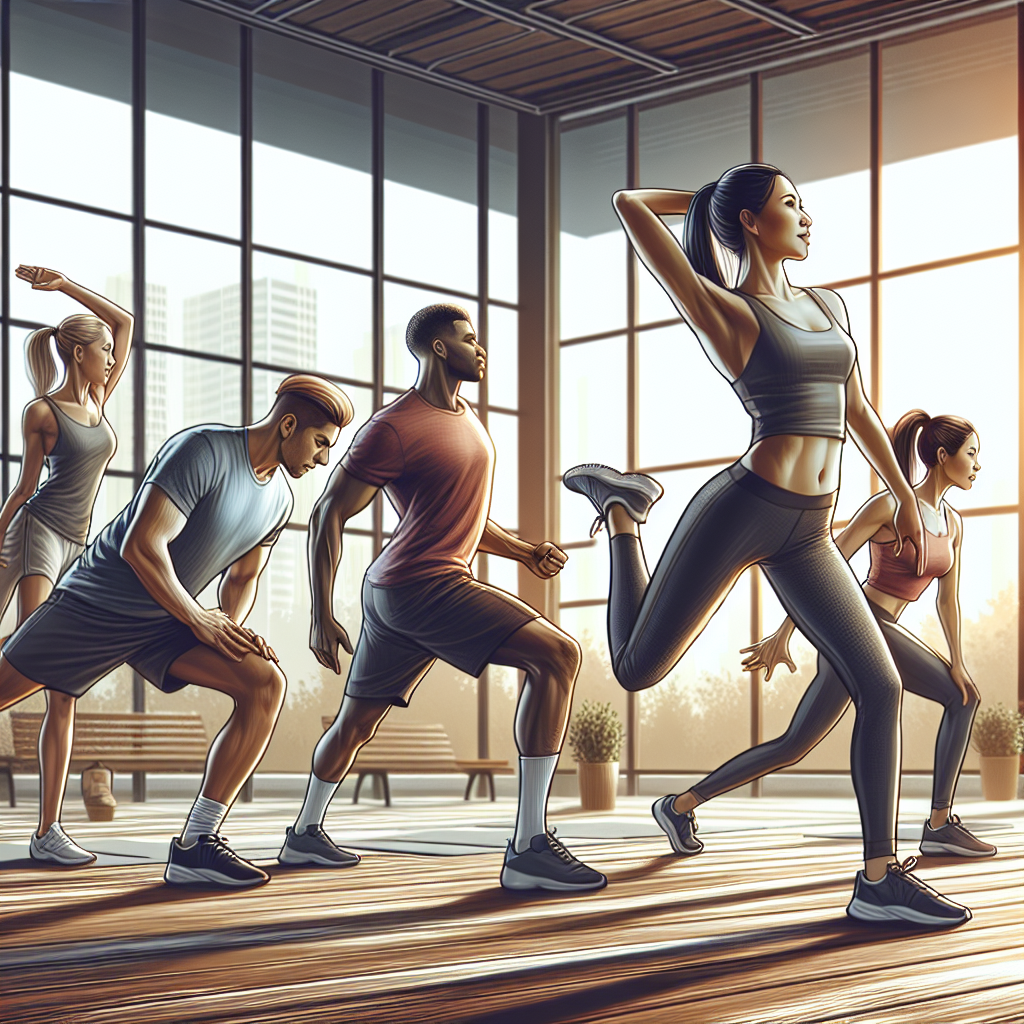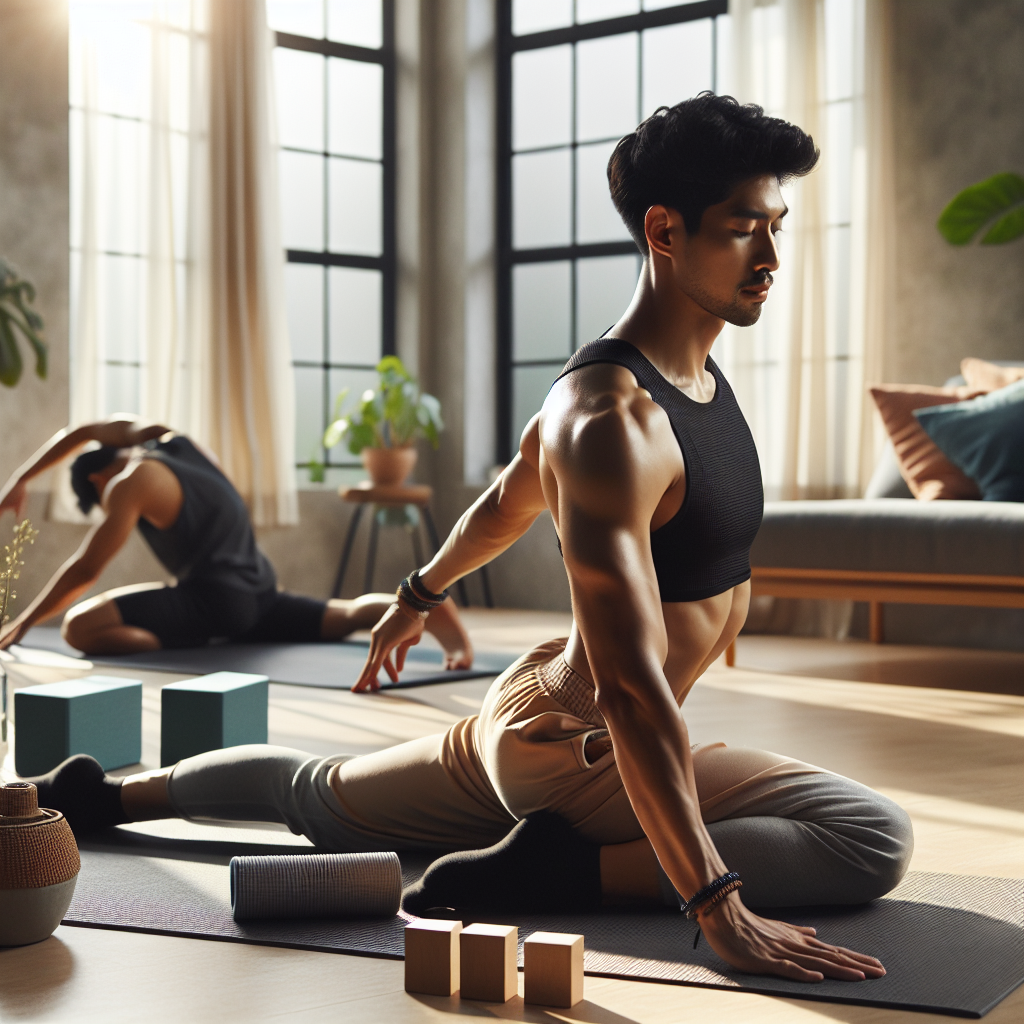Starting with larger muscle groups like the glutes, quadriceps, and hamstrings makes stretching more effective since these muscles control most daily movements and boost blood flow throughout the body.
Stretching Foundations for Effective Warm-Ups
Dynamic stretches form the backbone of a well-structured routine because they activate multiple muscle groups simultaneously and prepare the body for physical activity. Prioritizing major muscles ensures your body warms up faster, increasing blood circulation and flexibility.
Key Takeaways
- Start with large muscles (glutes, quads, hamstrings) to establish better blood flow and warm-up efficiency
- Begin with dynamic stretches for 5-10 minutes before moving to static stretches
- Target your core and back early on since they connect upper and lower body movements
- Align stretches with your workout by targeting the primary muscle groups involved
- Follow a head-to-toe sequence to ensure a complete, balanced stretching session
Dynamic Movements for Muscle Activation
I focus on dynamic movements first to prime my muscles and joints for exercise. This dynamic start reduces injury risk and enhances workout readiness. By using a systematic progression through muscle groups, I maximize the impact of each stretch.
Incorporating a Strategic Routine
Each session builds on a proven foundation, embedding movements tailored to the specific demands of my planned workouts. The stretching sequence flows smoothly, preparing the body for peak performance with efficient warm-up transitions.
Start with Your Largest Muscles for Maximum Benefits
Starting with your largest muscle groups sets the foundation for an effective stretching routine. I recommend targeting the powerhouse muscles — your glutes, quadriceps, and hamstrings first. These muscle groups handle most of your daily movements and need extra attention to properly loosen up.
Key Benefits of Starting with Large Muscles
Your body’s major muscle groups act as catalysts for improved blood flow throughout your entire system. By beginning your stretching session with large muscles, you’ll create a domino effect of benefits that support the rest of your stretching routine.
- Increased blood circulation to all body parts
- More efficient warm-up for smaller muscle groups
- Better overall flexibility gains
- Reduced risk of injury during stretching
- Enhanced muscle recovery potential
Think of your large muscles as the body’s primary energy consumers — they need more time and attention to warm up properly. Starting your stretching routine with these areas helps your body gradually adapt to the increased range of motion you’re asking of it.
The sequence matters too — I suggest starting with your glutes, moving to your quadriceps, and then focusing on your hamstrings. This order helps maintain balance in your stretching routine while maximizing the benefits for your entire lower body. Understanding these stretching benefits can help you stay motivated and consistent with your routine.

Why Dynamic Stretches Should Lead Your Routine
Dynamic stretches deserve their spot at the start of your stretching routine since they effectively activate multiple muscle groups at once. I’ve found that starting with dynamic movements creates a natural progression that helps your body adjust to physical activity. Following a structured stretching routine that begins with dynamic movements sets you up for success.
Essential Dynamic Movements to Start With
Before diving into static stretches, I recommend spending 5-10 minutes on dynamic movements to raise your heart rate and body temperature naturally. Starting with proper stretching technique through dynamic movements can make a significant difference in your flexibility journey. Here are key dynamic stretches to incorporate at the beginning of your routine:
- Leg swings (forward/back and side-to-side) to warm up your hips and legs
- Arm circles (both directions) to loosen your shoulders and upper body
- Hip rotations to increase mobility in your core and lower back
- Walking lunges to engage your legs and improve balance
- Torso twists to activate your core muscles
These movements help prevent injury by gradually preparing your muscles for more intense stretching or exercise. Understanding stretching benefits starts with recognizing how dynamic movements improve blood flow and muscle activation. Once you’ve completed these dynamic stretches, your body will be ready for deeper, static stretches.
Timing your stretching sessions correctly with dynamic movements first helps maximize the benefits of your entire routine. I’ve noticed that people who skip this crucial warm-up phase often don’t get the full advantages of their stretching practice. By prioritizing dynamic stretches, you’re setting a solid foundation for improved flexibility and reduced risk of strain.

Core and Back: Your Body’s Foundation
Starting With Your Center
I always recommend beginning your stretching routine with the core muscles since they connect your upper and lower body. Your core acts as the central hub for movement, making it crucial to activate these muscles first. By focusing on your core initially, you’ll gain multiple stretching benefits, including better posture and increased stability throughout your entire workout.
Essential Core and Back Movements
The key to effective core and back stretching lies in gentle, controlled movements that target multiple muscle groups. Starting with your core helps activate deeper stabilizing muscles, setting a solid foundation for the rest of your stretching session. Here are the fundamental stretches I recommend for your core and back:
- Cat-Cow Poses: These movements warm up your spine while engaging your core muscles
- Gentle Spinal Twists: Perfect for improving rotation and flexibility in your torso
- Pelvic Tilts: Help activate your deep core muscles and release lower back tension
- Child’s Pose: Provides a gentle stretch for both your back and core simultaneously
- Modified Planks: Engage your core while maintaining proper spinal alignment
Starting a proper stretching routine with your core and back muscles helps prevent common exercise-related injuries and creates a stable base for other movements. Remember to keep your movements slow and controlled, paying attention to your breathing. As you stretch, focus on maintaining proper form rather than pushing too far too fast.
I recommend holding each stretch for 15-30 seconds while maintaining steady breaths. This approach allows your muscles to relax properly and maximizes the benefits of each movement. By prioritizing your core and back stretches, you’re setting yourself up for a more effective and safer overall stretching experience.
Progress to Your Target Exercise Area
The most effective approach to stretching starts with targeting the specific muscle groups you’ll use in your workout. I’ve found that this targeted method helps activate the right muscles while improving their range of motion before intensive exercise.
Matching Stretches to Your Workout
Your stretching routine should directly connect to your planned exercise. Here are key muscle groups to prioritize based on different activities:
- For upper body workouts: Start with shoulder rolls and arm circles, then move to chest and back stretches
- For running or leg days: Begin with hip flexors and hamstrings, followed by calf and quadricep stretches
- For core workouts: Focus first on lower back stretches, then move to oblique and abdominal stretches
- For full-body training: Start with gentle neck rotations, working down through the body systematically
This targeted approach isn’t just about warming up – it’s about preparing your muscles properly for exercise. By focusing on the specific areas you’ll be training, you’re setting yourself up for better performance and reduced risk of injury.
I recommend spending extra time on any particularly tight areas related to your planned activity. For example, if you’re planning a run but know your calves are often tight, start there before moving to other leg muscles. This personalized stretching approach helps address your unique needs while preparing for your workout.
The timing of these stretches matters too – choosing the right time to stretch can impact your workout effectiveness. I suggest starting with lighter, dynamic stretches for your target areas before transitioning to deeper, static stretches if they’re appropriate for your activity.
Remember that while targeting specific muscle groups is important, don’t completely ignore other areas of your body. A brief full-body warm-up followed by focused stretching of your workout-specific muscles creates the best foundation for any exercise session.
The Essential Head-to-Toe Sequence
Starting with your neck and shoulders makes perfect sense – these areas hold tons of tension from daily activities like working at a computer or looking down at your phone. I recommend beginning with gentle neck rotations and shoulder rolls to release that built-up stress and get your blood flowing.
Following Your Body’s Natural Flow
After loosening up your upper body, I suggest moving to your core and back muscles. These central areas act as the foundation for all movement, so giving them proper attention sets you up for success. This connects perfectly with my complete stretching routine guide that’ll help you master each movement.
Here’s my recommended sequence to follow:
- Neck: 5-6 gentle rotations in each direction
- Shoulders: 8-10 forward and backward rolls
- Core: Cat-cow stretches and gentle twists
- Back: Child’s pose and forward folds
- Hips: Figure-4 stretch and hip flexor lunges
- Legs: Hamstring and quad stretches
- Ankles and feet: Ankle circles and toe spreads
This head-to-toe approach takes just 10-15 minutes but delivers amazing benefits. Understanding stretching’s key benefits can help you stay motivated to maintain this routine.
The sequence flows naturally through your body’s interconnected muscle groups. Your ankles and feet might seem less important, but don’t skip them – they’re crucial for balance and stability. If you’re new to stretching, I’d suggest checking out proper stretching techniques for beginners to ensure you’re doing each movement correctly.
Whether you prefer morning or evening stretching sessions, this sequence remains effective. I always remind my clients that consistency matters more than timing – stick to what fits your schedule best.
